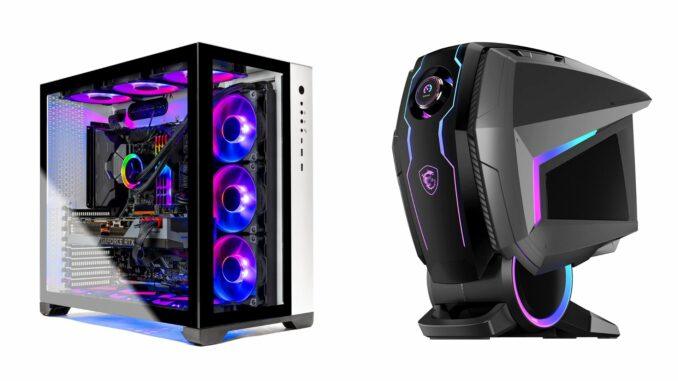
Please note: As an Amazon Associate I earn from qualifying purchases. I also work with other affiliate partners and may be compensated from the links below. Details here.
Sometimes when you’re shopping around for a new bit of hardware, it’s really important to know that you’re getting the best performance per dollar. Other times, you might be looking for the best you can get while sticking to a given budget.
For those individuals for whom money is no object, it might just be a case of looking for the absolute best of the best, the pinnacle of modern consumer-grade processing.
If that’s your aim, or if you just enjoy indulging in a bit of internet window shopping from time to time, then our list of the most expensive gaming PCs money can buy in 2023 will have the fix you’re looking for.
Most Expensive Gaming PCs in 2023 Round-Up
The table below will give you a quick look at the eight most expensive gaming PCs currently available on the market. To read a full review, simply click on ‘review>>’ in the respective row.
Product | Image | Rating | |
1. SkyTech Prism II ''Most Expensive Gaming PC We Actually Recommend'' | 9.8 | ||
2. Alienware Aurora R14 Ryzen Edition ''Most Hated Prebuilt PC in 2023'' | 9.2 | ||
3. MSI MEG Aegis Ti5 ''Coolest and Most Expensive PC in 2023'' | 9.5 | ||
4. CyberPowerPC Gamer Supreme Liquid Cool Y60 ''Surprisingly Great Value'' | 9.8 | ||
5. MSI Aegis RS ''Editor's Pick'' | 9.5 | ||
6. ASUS ROG Strix GA35 ''Most Expensive PC from ASUS'' | 9.2 | ||
7. Corsair ONE i300 ''Most Expensive Compact PC' | 9.6 | ||
8. Thermaltake LCGS View 390 ''Most Expensive PC Noone Wants'' | 8.6 |
Quick tip:
When you have chosen your desired computer, you can also use custom stickers to decorate it. Choose your favorite colors, patterns, and text freely, making your computer the perfect showcase of your personal style. Whether it’s art graffiti, cute cartoons, or minimalist lines, there are more options on GS-JJ.com.
1. SkyTech Prism II
Chassis: Metallic Gear by Phanteks NEO Qube | CPU: Intel Core i9-12900K | Graphics Card: Nvidia GeForce RTX 3090 Ti | Motherboard: Intel Z690 | RAM: 32 GB DDR5 @ 4800 MHz | Storage: 1 TB SSD | Power Supply: 1000W 80 Plus Gold | Cooling: Air + Liquid AIO
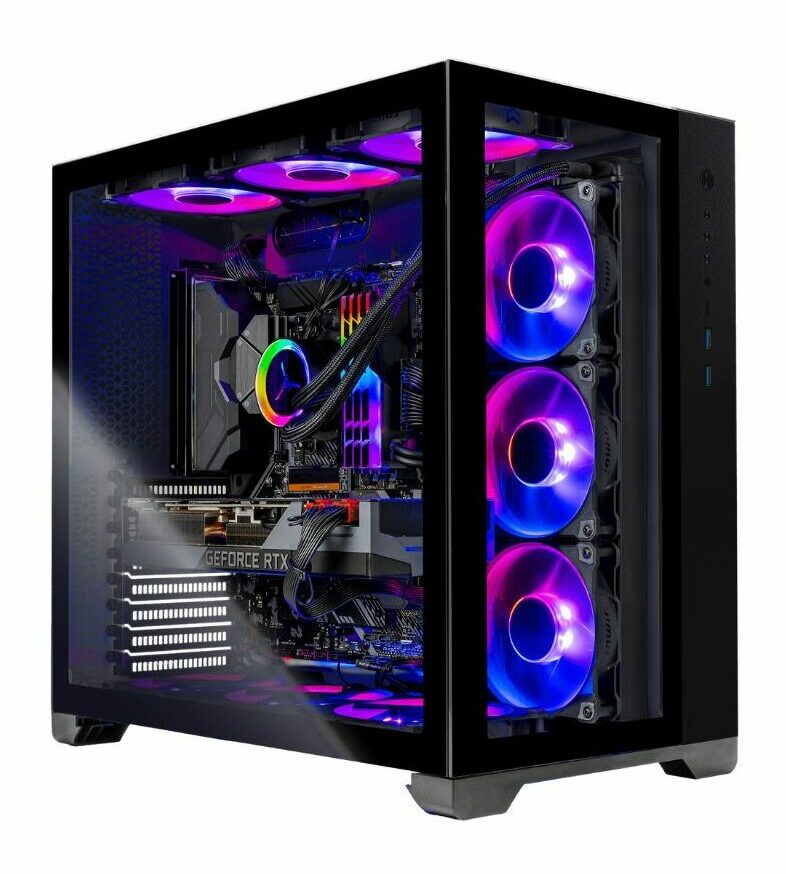
REASONS TO BUY
- Superior gaming performance
- Handles 4k gaming well
- Quality construction and cable management
- Actually a decent value for the money
- Great cooling (liquid cooling for the CPU)
- Flashy design with lots of RGB
- Full view of the interior
- Easily upgradeable
- Future-proof build
REASONS TO AVOID
- Limited storage (though easily upgradeable)
- Large and heavy
Our Rating: 9.8/10
The first PC we’ll be looking at is Skytech’s Prism II. While not the most expensive PC out there (it will still cost you upwards of 3 grand, though), it’s one of the few high-end computers that actually represent great value for the money. If you’re going to be spending top dollar on a gaming PC, it better be good at everything you throw at it.
That’s why we’re coming right out of the gates here with a PC that’s packing both the best consumer-grade CPU and GPU on the market. As far as raw gaming performance goes, it doesn’t get any better than this. Plus, you get an excellent chassis, cooling, and upgradability options which we’ll all cover in this review.
Currently, the two consumer-grade CPUs competing for the highest rank on benchmarking charts are AMD’s Ryzen 9 5950X and Intel’s Core i9-12900K. While more powerful and notably more expensive CPUs certainly exist, CPU lines like AMD’s EPYC and Threadripper or Intel’s Xeon are designed to meet specific use cases.
They were made to handle servers in high-speed data centers and thrive in similar environments, essentially, environments where graphical performance isn’t a primary concern. We wouldn’t expect to see any of these kinds of CPUs in a ‘gaming’ branded PC.
Because of that, when considering the ‘best’ modern CPUs for gaming, the Ryzen 9 5950X and the Core i9-12900K are going to be the two we’re looking at. Of these two, the Intel chip tends to perform just a bit better, and SkyTech is aware of it–They packed this PC with a 12900K, so you’re getting the best CPU for gaming (and other single-core operations).
To help turn that incredible processing power into actual visible FPS in games, Skytech is also opting for the most powerful GPU that has ever been made. Nvidia’s RTX 3090 Ti is an absolute monster when it comes to graphical processing power. The only GPU that even comes close to competing is AMD’s Radeon RX 6950 XT, and the 3090 Ti is still ahead by a decent margin.
We could talk about what these components mean for your gaming performance, and we will, but put simply, this is literally as good as it gets. 4K 144hz gaming is still going to be a bit of a stretch in this day and age, but 60fps at 4k will be an easy mark for this PC to hit when rendering any game in existence, even at the highest settings. When you drop the resolution down to 1440p, we can then definitely expect 144fps out of almost every title, with a few exceptions.
In terms of memory, you’re getting 32 GB of the new-gen DDR5 RAM clocked at 4800 Mhz which is currently overkill for gaming, but you’ll appreciate the futureproofing and the lighting-fast speed (The average DDR4 modules were clocked at 3200 Mhz). Plus, you will also be afforded a decent bit of headroom for running extra programs.
The weakest part of this PC is storage. While 1TB is generally a good amount, when buying one of the most expensive gaming PCs, you want to have a generous amount of memory. And, with the average AAA title being 50GB or more, you will be forced to upgrade rather quickly.
With that being said, RAM and drive storage are the easiest two parts of a PC to upgrade. Falling short in these areas isn’t going to be crippling to this PC’s value. It’s still a great purchase for the price. It’s just a little bit underwhelming to see these low numbers in such a high-end gaming PC.
As far as cooling, the PC comes equipped with 9 RGB fans that do a good job of keeping everything cool, even while under heavy loads. In addition to that, SkyTech opted for liquid cooling for the CPU, specifically an Asetek 360mm AIO cooler–It’s not the most popular liquid cooler out there, but Asetek coolers are built to last and do a good job of keeping the processor nice and cool.
As we mentioned earlier, Skytech’s Prism II is one of the most expensive PCs we’d actually recommend you buy if you’re looking for a top-of-the-line pre-built. It offers incredible performance, clean design, excellent cooling, and beautiful aesthetics. On top of that, SkyTech PCs are built by trained professionals (they regularly stream the building process on Twitch), so you don’t have to worry about things like poor cable management, bad thermals, or anything like that.
- YOU MAY ALSO LIKE: Best Prebuilt PCs for 4k Gaming
2. Alienware Aurora R14 Ryzen Edition
Chassis: Alienware Aurora | CPU: AMD Ryzen 9 5950X | Graphics Card: Nvidia GeForce RTX 3090 | Motherboard: AMD B550A | RAM: 64 GB DDR4 @ 3200 MHz | Storage: 1 TB SSD + 1 TB HDD | Power Supply: 750W 80 Plus Platinum | Cooling: Air + Liquid AIO
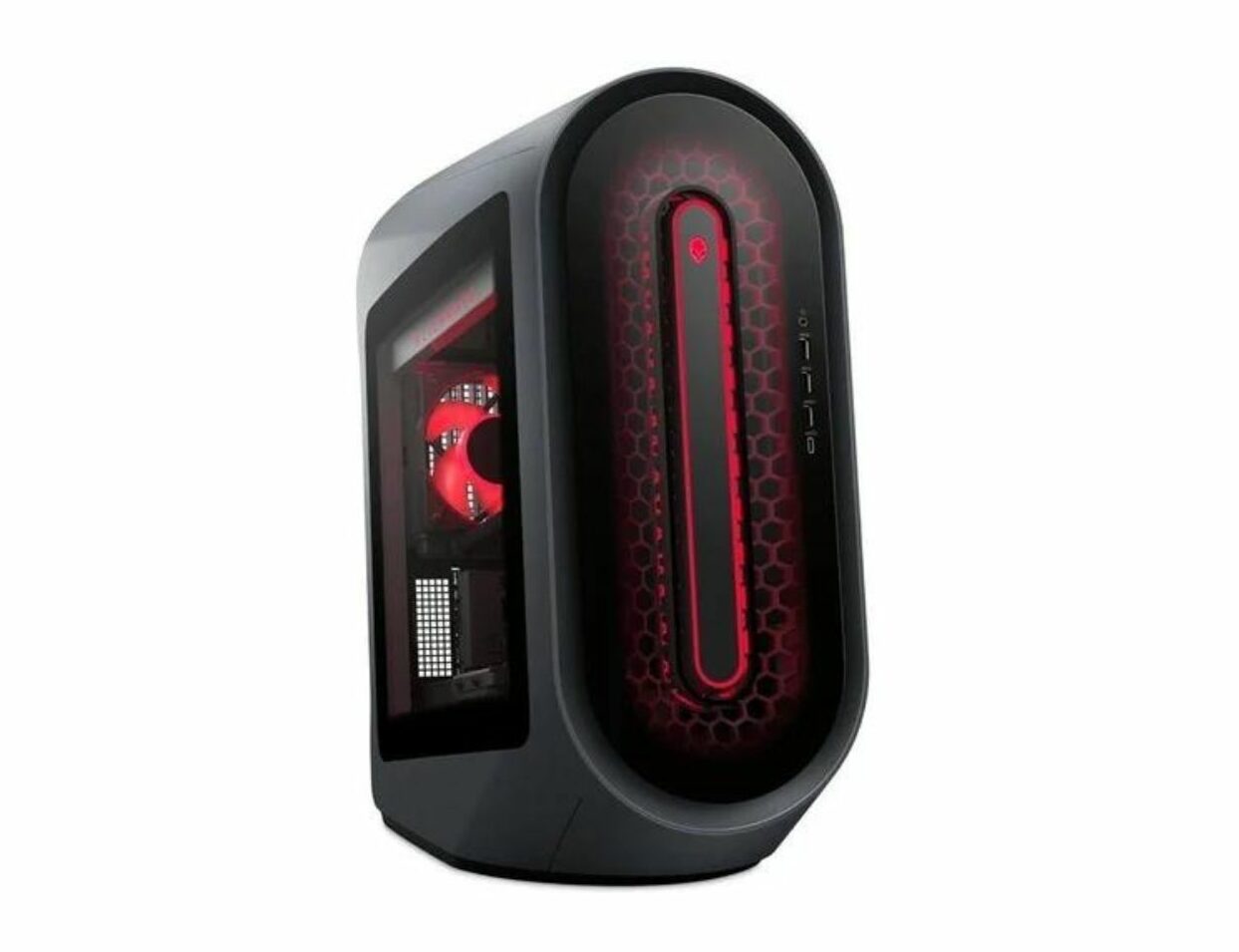
REASONS TO BUY
- High-quality construction
- Beautiful aesthetics
- High performance for gaming
- Good amount of memory (both RAM and storage)
- Lots of customizable RGB lighting
- Great connectivity
REASONS TO AVOID
- Bad upgradability
- Definitely overpriced
- Average cooling system
Our Rating: 9.2/10
Is there still anyone who isn’t familiar with the Aurora gaming PC from Alienware? Probably not. But, just in case you haven’t heard of it yet, let us introduce it.
The Alienware Aurora R14 is the 14th revision of the Aurora PC (hence the R14), and it’s the best we’ve seen yet. It still has a couple of shortcomings which we’re going to cover; however, when discussing the most popular, best-performing, and most expensive gaming PCs, the Alienware Aurora is one of the first names that comes to mind.
Let’s first discuss the performance. Instead of the RTX 3090 Ti that the Prism II has, we’ll be dropping down a bit to the standard 3090. This is a minor enough downgrade that most of the performance standards set by the Prism II will still hold true.
At 1440p, you’ll be able to hit 144 FPS on most titles, and at 4K, you can expect 60+ FPS. The only time you might end up noticing the difference between the two would be when playing the most demanding AAA titles.
In addition to that, you’re getting an AMD Ryzen 9 5950X processor. Similarly to most super-expensive PCs, the processor is a complete overkill for gaming but makes the PC versatile and excellent for multi-core applications and productivity.
On top of the quite-incredible processors this computer has, it also comes with a substantial upgrade to both RAM and storage when compared to the Prism II model we reviewed. Both random access and bulk storage potential are actually doubled.
64GB of RAM is about what we’d like to see from a PC in this price range. There are going to be few users who ever do use more than 32GB and even fewer whose needs would ever surpass this 64GB. This amount of RAM is enough to allow you to exceed the requirements for every game in existence for the foreseeable future.
While rendering those games, you’ll also be able to keep multiple other programs running without it slowing down your PC at all. This will open up a lot of possibilities for potential multitasking, especially when paired with a CPU as powerful as the Ryzen 9 5950X.
Likewise, 2TB of storage would be a better baseline for top-tier PCs like this one. It still isn’t quite ideal, but it’s a lot better to work with than only having 1 TB. For the Aurora R14, these 2 TB of storage are split between an NVMe drive and a standard HDD.
While in an ideal PC, all of its storage would be lightning-fast NVMe, the difference can be mitigated by using your storage smartly and efficiently. If you play a wide array of games, you’ll want to have your large single-player type games on your NVMe and your multiplayer games on your HDD.
The reason why it isn’t a big deal to be having your multiplayer games on a disk drive is that when loading into multiplayer lobbies, you’re always going to have the quickness of your load times limited by the weakest participating link. In a 10-person lobby, if only one person has slow drives or slow internet speed, the other 9 players will still have to wait for them to load in before getting into the game. In single-player games, the only limit will always be your own hardware.
When it comes to the design of this PC, you either love it or hate it. The truth is, the pictures don’t do a good justice–the PC looks stunning in real life. You get this clean-looking chassis with an array of LEDs, and everything feels high-end and premium. We understand it’s not everyone’s cup of tea, but even when you put aesthetics aside, you’re getting a quality build from top to bottom.
The two biggest drawbacks of this PC are, by far, cooling and upgradability. Cooling-wise, you only get a 120mm AIO cooler, which simply isn’t enough for a Ryzen 9 5950X. In comparison, the Prism II from SkyTech uses a 360mm Asetek cooler–Although the 12900k produces noticeably more heat than its AMD counterpart. You do get 4 RGB fans which produce good airflow, but still, the cooling could’ve been handled in a much better way.
In terms of upgradability, we’re really baffled by the lack of M.2 slots. There is only one M.2 slot which limits you to only one NVMe drive. The absolutely worst part is when you want to upgrade, you have to spend twice the amount of money you’d normally spend because you’re replacing a drive, not adding a second drive to an existing one.
If you’re here just to check out some of the most expensive gaming PCs, the Aurora may look exciting to you–It’s a flashy, high-performing, premium gaming PC that grabs attention at first sight. However, for those of you who’re actually looking to buy a PC, we can’t recommend this one. The cooling isn’t ideal, and the upgradability isn’t what it should be when you’re spending this much money. Compared to something like the Prism II or the Aegis Ti5 from MSI, this PC doesn’t stand a chance.
- READ ALSO: Best Budget Prebuilt Gaming PCs
3. MSI MEG Aegis Ti5
Chassis: MSI MEG Aegis Ti5 | CPU: Intel Core i9-12900K | Graphics Card: Nvidia GeForce RTX 3080 Ti | Motherboard: Intel Z690 | RAM: 128 GB DDR5 @ 4800 MHz | Storage: 6 TB SSD + 2 TB HDD | Power Supply: 750W 80 Plus Gold | Cooling: Air + Liquid AIO
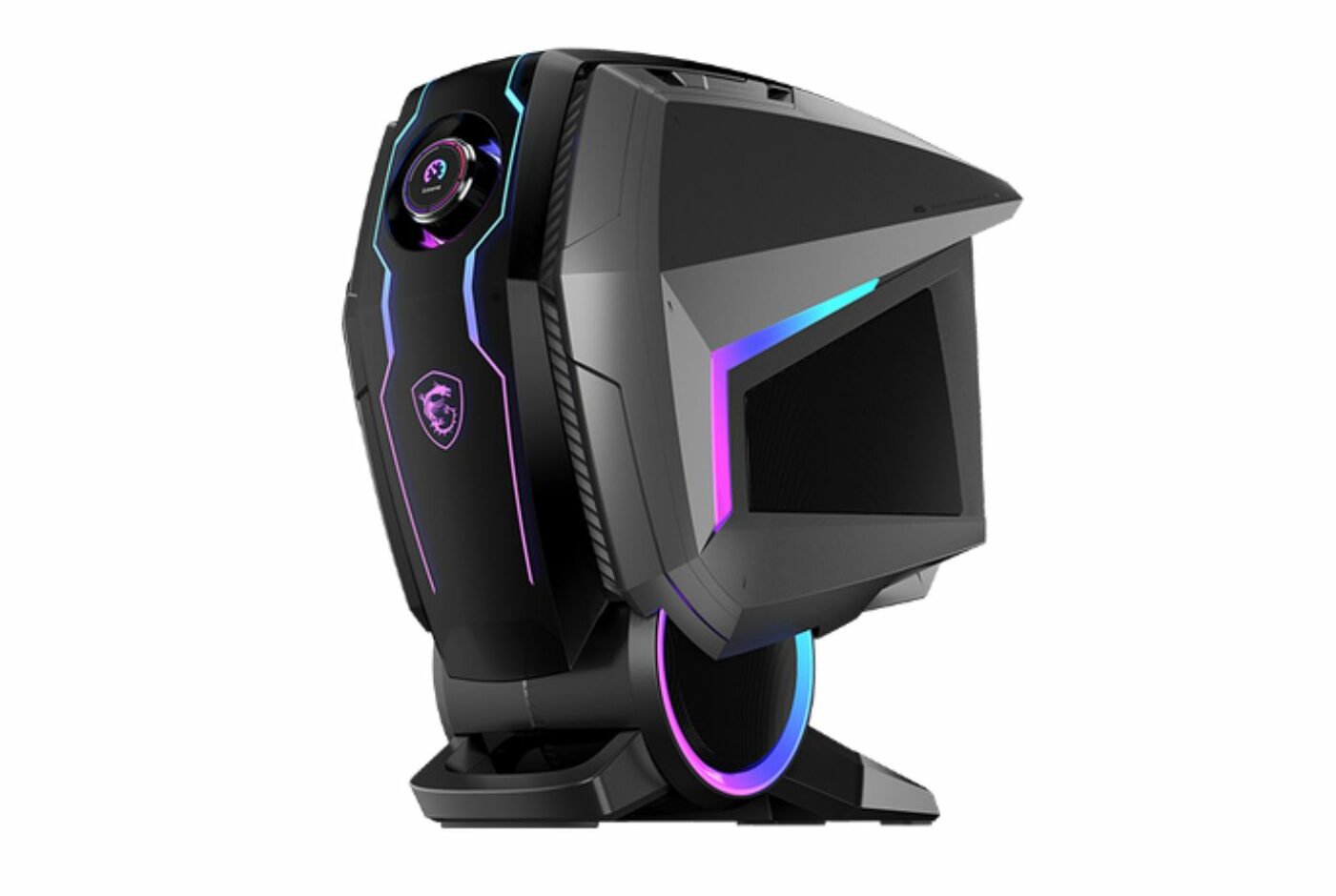
REASONS TO BUY
- The coolest prebuilt PC out there
- Excellent gaming and general performance
- Loads of RAM and storage
- Plenty of fully customizable RGB
- Unique Gaming Dial with a variety of uses
- Excellent connectivity
- Good airflow and cooling
- Neat cable management
REASONS TO AVOID
- Hard to justify the price tag
- Gets loud under heavy loads
- Mostly plastic construction
- Difficult to upgrade
Our Rating: 9.5/10
The MSI MEG Aegis Ti5 takes almost every single feature of a regular gaming PC to the next level, including the price tag. This is the most expensive PC you can buy in 2023, and it’s clear to see why. From extravagant design and high performance to excessive amounts of RAM and storage, this PC is every gamer’s dream. However, there are some significant drawbacks that make this PC not a particularly great buy compared to the competition.
Before we dig into the impressive memory included in this PC, let’s make sure we look at how this PC actually performs when it comes to gaming. We’ll start off by saying that if you aren’t the kind of user who actually needs all that memory, it won’t be the most cost-effective purchase.
Don’t get us wrong here; the 3080 Ti is an incredible graphics processing unit. However, with this list, we aren’t just looking for incredible. We’re looking for the best. The 3080 Ti is not quite the best. At 4K, you’ll still be reliably hitting 60FPS. It’s at 1440p where we are going to start expecting that you might not be hitting your ideal benchmarks.
When it comes to some of the most demanding recent titles, that buttery smooth 144FPS goal is going to be just a little bit out of reach. If you have a monitor that supports G-Sync, and most monitors these days do, you can still avoid any egregious screen tearing. You’ll also still definitely be crushing console performance with well over 60FPS in all cases.
CPUs are a little bit less straightforward than GPUs. Technically speaking, the i9 12900K is a less powerful processor than the Ryzen 9 5950X. However, as with most decisions in the tech world, there is a tradeoff to consider. While AMD processors are usually overall more powerful at the high end, Intel is still managing to edge them out when it comes to per-core performance.
As far as memory, 128GB of RAM is a LOT. If you’re wondering if you would be able to make use of that much RAM, the answer is most likely “No”. If you need 128GB of RAM on a day-to-day basis, you’ll know exactly what you need it for. Here’s an example of what you could be doing with your PC and still not need that much RAM.
Without even using up 64GB, you could be playing a multiplayer survival game like Minecraft/Valheim/Rust/etc., hosting a dedicated server for that game, participating in a discord call with the server’s current players, listening to a music player, watching a video/show/stream, keeping internet browser tabs open for 5 different guides, running Windows 11, and heck maybe even rendering your own video on an editing program.
8TB of total storage, however, is a bit more of a conceivable need for gaming enthusiasts. If you play a lot of different modern titles, this figure might be especially appealing to you. Barring any extreme cases, you might even be able to fit your whole library of games on your computer without having to worry about removing anything for more space.
Design is another feature where this PC offers a unique experience. You get a unique design from top to bottom, along with plenty of RGB lighting, which, surprisingly, isn’t overdone. It is a 5-zone lighting that can be fully customized to your heart’s content.
Besides that, there are no glass side panels; instead, MSI opted for meshed panels, which provide excellent airflow but don’t allow for a view inside the case, so there is no showcasing of your components.
To make up for that, MSI included a tinted window at the top of the case that allows for a full view of your GPU–pretty neat, but unless you plan on placing the PC on the floor where you can see the top panel, this feature is pretty much useless.
Not only does the case look cool, but it also has an awesome feature built into the front panel. You get a ‘Gaming Dial’ with an OLED display that can integrate with MSI’s software to provide easier access to some of the MSI center’s features, such as controlling the lighting, displaying temperatures of your components, as well as custom images you can upload via the software.
As far as cooling, this PC comes with MSI’s MAG Core Liquid 240mm AIO cooler, which does a great job of keeping your CPU nice and cool. As we mentioned earlier, the mesh panels provide great airflow; however, they don’t seal the case as a typical glass panel would, so the PC gets pretty loud under heavier loads-the maximum we measured was 61 dBa.
Overall, the MSI MEG Aegis Ti5 is by far the coolest and most expensive gaming PC currently available on the market. If you’re not looking to build a PC yourself, have a large budget, and looking for something no one else has, you’ll be hard-pressed to find anything better.
- RELATED ARTICLE: Best PC for 1440p 144hz Gaming
4. CyberPowerPC Gamer Supreme Liquid Cool Y60
Chassis: Hyte Y60 | CPU: Intel Core i9-12900KF | Graphics Card: Nvidia GeForce RTX 3090 | Motherboard: Intel Z690 | RAM: 32 GB DDR5 @ 4800 MHz | Storage: 2 TB SSD + 4 TB HDD | Power Supply: 1000W 80 Plus Gold | Cooling: Air + Liquid AIO
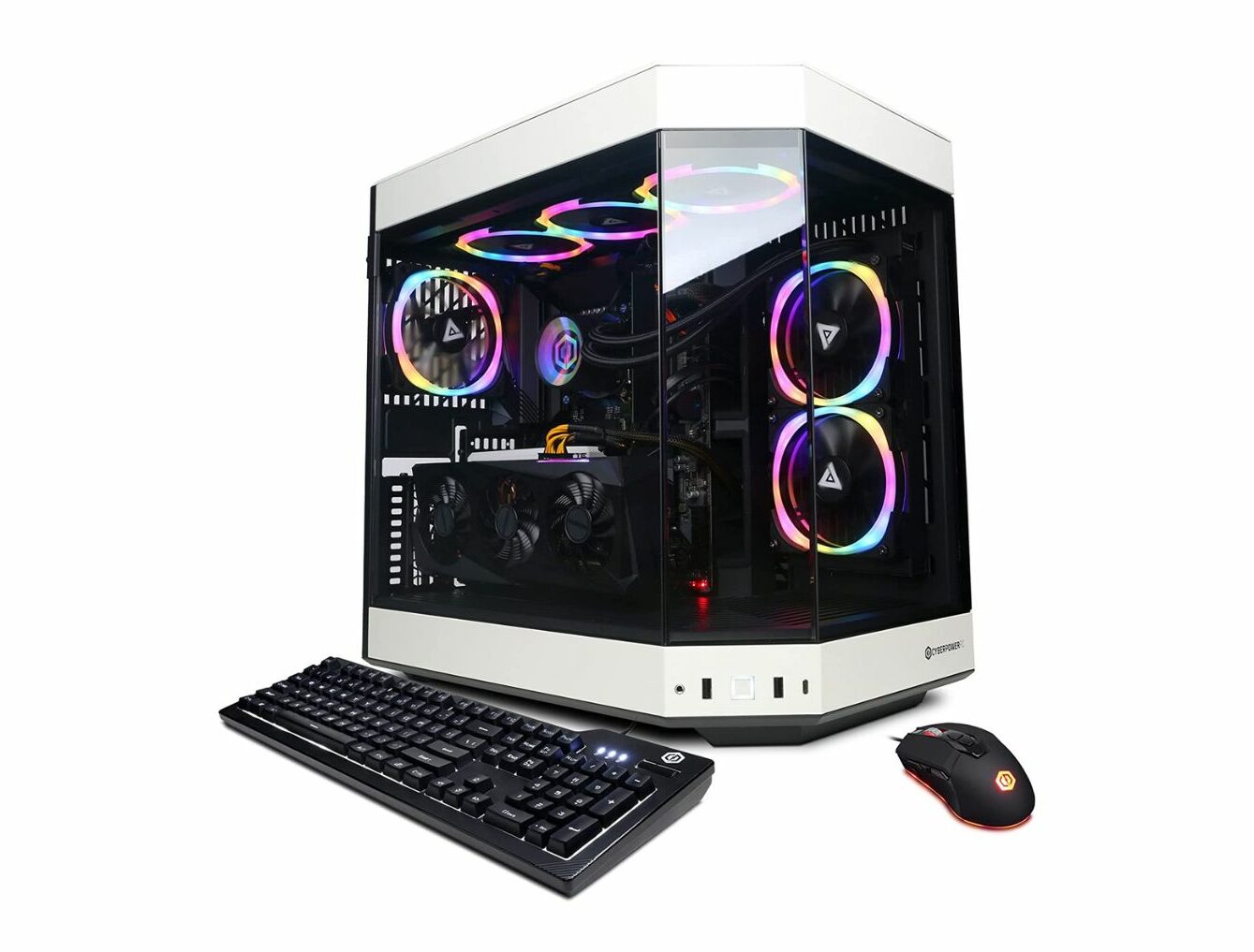
REASONS TO BUY
- Actually a great value for the money
- Excellent gaming performance
- 32GB of DDR5 RAM
- Large amount of storage
- Excellent cooling
- Stays quiet even under load
- Highly upgradable
- High-quality case with great airflow
- Great showcasing potential
REASONS TO AVOID
- Large and heavy
- Poor quality of included peripherals
Our Rating: 9.8/10
CYBERPOWERPC earns the next spot on our list with their Gamer Supreme Liquid Cool Y60. This PC might be the best all-around PC on our list. While the previous entries all outshine it in one way or another, this PC doesn’t really fall short in any aspect. Instead of being the best at any one thing, it’s just great at everything.
First off, the CPU and GPU are both what we might call the second-best consumer-grade options on the market.
Intel’s Core i9 12900KF is essentially identical to the 12900K, except for the fact that the 12900KF doesn’t support Intel’s integrated graphics. This doesn’t mean anything for gaming performance, as you’ll always be using your dedicated GPU for graphics processing instead.
The only reason why having the integrated graphics might ever be useful would be if your GPU were to fail. In that case, the integrated graphics would allow you to continue using your PC while you’re still working on solving the issue.
CYBERPOWERPC isn’t really known for having the best customer service, so in the case that that did end up happening, you might be in a rough spot. It isn’t likely that you’ll run into that particular issue, but just in case you like to err on the side of caution, it might be a factor worth keeping in mind.
As we stated with the Aurora R14 Ryzen Edition, the RTX 3090 is an insanely good GPU. Yes, it falls short of the 3090 Ti by a little bit, but if you’re upgrading from a rig with a GPU from the previous generation or before, it’s still a card that will absolutely blow you away. Whether you’re gaming at 4K 60fps or 1440p 144fps, this card isn’t ever likely to let you down.
32GB of RAM might also be just shy of what you’d want out of a top-of-the-line PC, but again, for most users, it’ll be more than enough. Also, as we mentioned with the Prism II, RAM is the easiest thing to upgrade if you’re finding the amount you have to be lacking. 64GB might be a more appealing figure for one of the most expensive PCs, but it’s also entirely possible that you wouldn’t ever need more than 32GB.
In terms of storage memory, what we’re seeing here is pretty much perfect. 2TB of NVMe is a great amount to have for your operating system, and a decent handful of games. Adding 4TB of disk storage on top of that is also going to give most users plenty of space for those other kinds of files and programs that aren’t as demanding of fast load times.
The other win that this PC definitely has over some of the others is its value for the money. While we’re covering the most expensive gaming PCs on the market, it’s nice to be able to point to one that has all the high-end performance and specs and say this one is actually worth the money.
Speaking of value, you also get a mouse and keyboard with the purchase of this PC, which is something not every PC manufacturer includes. Both the keyboard and mouse are of somewhat OK quality and will serve you well if you have no peripherals of your own. However, they stand no chance in comparison to Razer or Logitech peripherals, for example. And you won’t most likely enjoy using them if you’re used to premium-quality peripherals.
Now, as far as the overall quality and construction, we have no complaints. The cable management is great, everything is easily accessible and upgradeable, and the case CyberPowerPC used for this build is one of our favorites. It’s a Y60 case from Hyte, and it’s the best case they’re currently offering–It’s super high-quality, has good airflow, plenty of space for cable management, and everything is extremely well thought out.
When it comes to cooling, you also have nothing to worry about, courtesy of the excellent case, 360mm AIO liquid cooler for your CPU, and three RGB fans on top of that. Aesthetics-wise, the RGB lighting is fully customizable, and when it comes to cooling performance, both GPU and CPU stay within safe operating temperatures, even when overclocking.
Overall, we really enjoyed this PC and recommend it to gamers who’re looking for a premium prebuilt PC. Yes, it’s a super-expensive PC, but everything from performance to quality, aesthetics, cooling, and upgradability are top-notch. Along with the Prism II from SkyTech, this is one of the best high-end PCs on the market in 2023.
- RELATED READING: Best Budget PCs for Streaming
5. MSI Aegis RS
Chassis: MSI MPG Gungnir 110M | CPU: Intel Core i9-12900K | Graphics Card: Nvidia GeForce RTX 3090 | Motherboard: Intel Z690 | RAM: 32 GB DDR5 @ 4800 MHz | Storage: 2 TB SSD + 2 TB HDD | Power Supply: 1000W 80 Plus Gold | Cooling: Air + Liquid AIO

REASONS TO BUY
- Excellent gaming performance
- New generation RAM
- Excellent storage configuration
- Every component is MSI (High-quality)
- Good connectivity
- Highly and easily upgradeable
- Efficient and quiet cooling
REASONS TO AVOID
- Some gamers may find the design boring
- No extra features
- Poor cable management
Our Rating: 9.5/10
Next up on our list, we got the Aegis RS from MSI. While it isn’t quite a top-tier PC, it has everything it needs to be just under top-tier in every regard. Both its CPU and GPU are the second best you could hope for, and its RAM and storage don’t leave anything to be desired. On top of that, despite being one of the most expensive PCs you can buy, its price is actually very reasonable for what you’re getting.
In terms of performance, having an RTX 3090 combined with a Core i9-12900K is going to cut you just shy of the bleeding edge of modern gaming hardware’s potential. We’re still at that awkward point where most of the time, you probably won’t really be able to notice a difference between this level of hardware and something better, but ultimately it’s up to each individual to make that call for themselves.
Since bottlenecks often exist elsewhere, regardless of your CPU and GPU, there are still plenty of circumstances where you’re better off just holding on to your money. For example, if you have a 4K monitor with a 60hz refresh rate, it isn’t going to mean anything that your setup can render a game at 4K 70fps rather than 60fps. Those extra 10 frames aren’t going to make any meaningful impact on your gaming experience.
So while yes, there are better processors you could hope for, it might not actually end up mattering to you in the long run. These two processors will be enough to get you to either 4K 60fps or 1440p 144fps benchmarks in most cases. You could extrapolate that to say that, for most users, this setup might actually essentially be the same as actually having the best of the best.
Once again, seeing a PC at this price range with only 32 GB of RAM is a bit underwhelming. It’s definitely not so little that we would suggest passing this PC up because of it, but having that extra 32 from a 64GB configuration would be a great comfort to have.
In terms of storage memory, the Aegis RS has just about the perfect amount. For most gamers, 2TB of NVMe and 2TB of disk storage will be more than enough to keep them covered. It could still be argued that a bit more storage would be a better fit for a high-end PC like this one, but it’s honestly going to be plenty for most gamers.
When we take a look at the case this PC is built with, we’re actually pretty impressed with what we see. It isn’t quite as flashy as its cousin, the MEG Aegis Ti5, but it’s still an attractive case with good airflow. If you’re into a more minimalist or utilitarian style of aesthetic, then you could probably even consider this to be a better design.
On top of that excellent case, the Aegis RS also comes packaged with a keyboard and mouse. The keyboard and mouse included aren’t the best of what MSI has to offer, but if you don’t have any yet, it’s a nice little bonus. Even if you do have a better keyboard and mouse to use, it’s definitely always good to have backups ready to go.
The MSI Aegis RS, despite being one of the most expensive gaming PCs in 2023, might not quite be the very best of the best. But all around, it’s a very solid choice. By modern gaming standards, this machine is nothing short of an absolute beast and is an excellent choice for gamers who want top performance in a more conventional case.
Even though it could be more future-proofed, you can always look to such a well-built case as a form of security in your potential future upgrades.
- YOU MAY ALSO LIKE: Best Budget AIO PCs
6. ASUS ROG Strix GA35
Chassis: ROG Strix GA35 | CPU: AMD Ryzen 9 5900X | Graphics Card: Nvidia GeForce RTX 3090 | Motherboard: AMD B550M | RAM: 32 GB DDR4 @ 3200 MHz | Storage: 1 TB SSD + 2 TB HDD | Power Supply: 850W 80 Plus Platinum | Cooling: Air + Liquid AIO
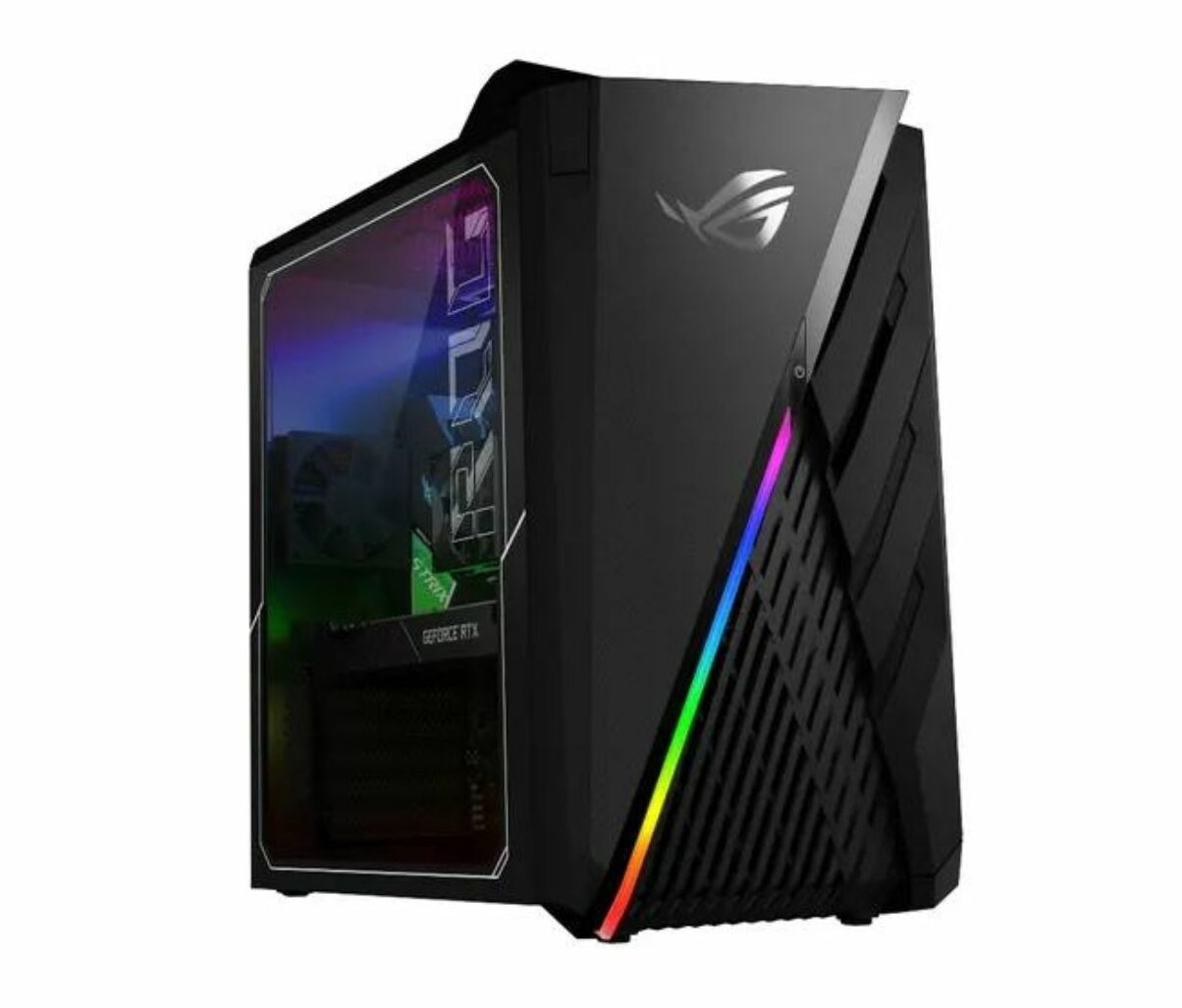
REASONS TO BUY
- Beautiful aesthetics with plenty of RGB components and vertical GPU
- Every component is from ASUS (premium quality)
- Excellent gaming performance
- Fantastic cooling system
- Good amount of storage and RAM
- High-quality construction
- Excellent connectivity (double USB Type-C)
REASONS TO AVOID
- Disappointing performance per dollar
- Slow DDR4 memory
- Only 1TB of NVMe storage
- Gets louder under heavy load
Our Rating: 9.2/10
‘ROG Strix’ is the name ASUS has branded onto all of their products that appear at the high-end of their lineups. Whether it be graphics cards, motherboards, or PSUs, you can safely assume that seeing ‘Strix’ in the title is going to automatically guarantee that you’re looking at the best version on the market. So does this principle hold up when it comes to ASUS’ premium gaming PC, the ROG Strix GA35?
This PC’s GPU is probably its highlight. Beyond that, it’s actually relatively modest. ‘Relatively’ is being used very intentionally here, as this rig’s baseline performance is anything but modest. However, when directly compared to the most expensive PCs on the market, it is falling a bit short of the competition.
Despite that, purchasing this PC would still mean getting your hands on an RTX 3090, which is an excellent investment for a PC of this price.
The Ryzen 9 5900X CPU included is also still very objectively powerful, just not quite as much as the 5950X or Intel’s i9-12900K chip. It still definitely packs enough of a punch to be a good match for the RTX 3090 but isn’t going to afford you quite as much headroom.
One good thing to note about this choice of CPU is that it does help to drop the price tag a bit, especially given that it’s a more cost-effective AMD chip.
What’s really nice about buying a PC from ASUS are the peripherals you’re getting in with the PC. These are no cheap peripherals you might be used to seeing with other manufacturers–Here, you’re getting ASUS’ Chakram gaming mouse as well as their Scope keyboard. These are good enough peripherals to be worthy of recommendation all on their own, and having them bundled adds to the overall value of the PC.
As far as RAM and storage, you’re getting a good amount of both, at 32GB of RAM clocked at 3200 Mhz and a total of 3TB of storage for all of your games and files. However, the RAM is only DDR4, meaning around 30% less performance compared to DDR5 modules.
And on top of that, you’re only getting 1TB of fast NVMe storage (the other 2TB are via HDD). While not bad, in comparison to other high-end PCs, it’s definitely not ideal, not to mention the lack of future-proofing.
Now, what may be the biggest draw of this PC are all the components inside–they’re all from ASUS, more specifically, the ROG line-up. That means every component is basically the best you can get in terms of quality and performance, from the AIO cooler to the GPU and motherboard.
The downside of it is that it feels like the price is a bit higher for the performance you’re getting. To put it simply, if you want the best performance per dollar, this isn’t it. If instead, you want each component in your PC to be of premium quality and don’t mind paying an extra couple hundred bucks for it, then this PC is the perfect choice for you.
Before we conclude our review of the ROG Strix GA 35, one last thing to mention is the computer’s aesthetic value. It follows the typical Strix design theme with striking angles, matte black, and gunmetal accents. It includes a vast number of subtle RGB elements which combine to create more of a cool glow than a brilliant shine.
All of this RGB, plus the RGB in the included mouse and keyboard, can be controlled in unison with ASUS’ Aura Sync software for a cohesive RGB setup. What’s really unique about this PC is the vertical mounting of the GPU, which does look really cool, especially with the beautiful ROG card.
Overall, ASUS’ ROG Strix GA35 isn’t the best gaming PC out there, but it definitely deserves a spot on this list. After all, you’re looking for the most expensive, premium PC on the market, and the GA35 fits the bill. As we mentioned, it doesn’t provide the best performance per dollar; however, the aesthetic value, along with the quality of each component, is unmatched.
- READ ALSO: Best Budget Mini PCs
7. Corsair ONE i300
Chassis: Corsair ONE | CPU: Intel Core i9-12900K | Graphics Card: Nvidia GeForce RTX 3080 Ti | Motherboard: Intel Z690 | RAM: 64 GB DDR5 @ 4800 MHz | Storage: 2 TB SSD | Power Supply: 750W 80 Plus Platinum | Cooling: Liquid Cooling for both CPU and GPU
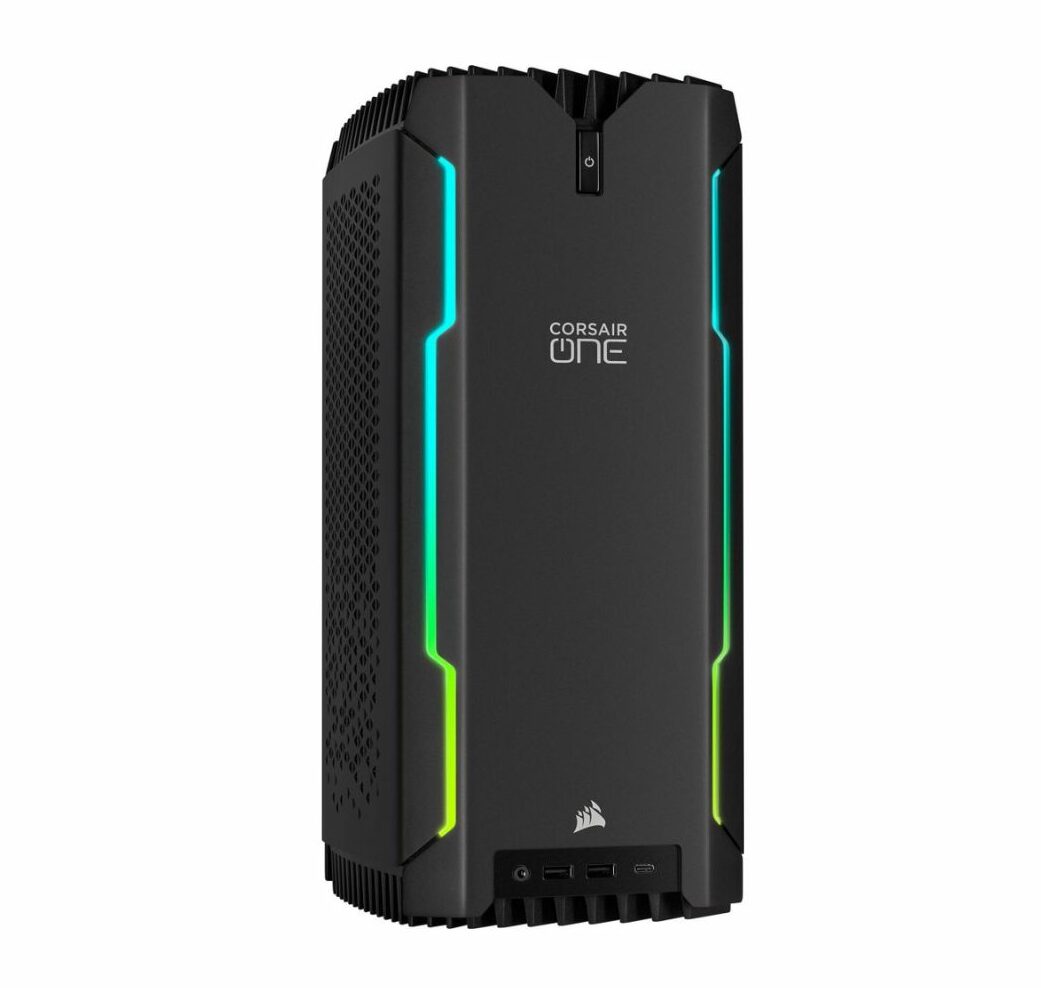
REASONS TO BUY
- Excellent build quality
- Highly compact and portable
- Excellent performance for such a small PC
- Easily handles 4k gaming
- Unique and efficient cooling system
- Almost every component is from Corsair
- Fantastic RAM configuration
- Platinum-rated PSU
REASONS TO AVOID
- Disappointing performance per dollar
- No configuration with RTX 3090
- Difficult to upgrade
Our Rating: 9.6/10
Corsair’s ONE i300 is a premium gaming PC that provides some serious processing power in a very compact yet well-cooled case. Similar to the GA35 from ASUS, every component is made in-house, so you can rest assured you’re getting a quality, long-lasting PC from top to bottom. But, with a price of around four grand, we’d only recommend it to those with very limited space needing a highly compact or highly portable gaming PC.
In terms of GPU, this model comes with an RTX 3080 Ti, which is the best video card that will fit into this PC. That is a slight step down from the ROG Strix GA35’s RTX 3090. This step down crosses right over the threshold of assurance for 4k 60fps and 1440p 144fps benchmarking. There will be a decent number of recent triple-A titles where it’ll fall just short of what you’d need to be rendering that well.
On the other hand, the Core i9-12900K CPU is actually a step up from the ROG Strix GA35’s Ryzen 9 5900X. So, when it comes to productivity, and when it comes to games that are particularly demanding of CPUs (and other CPU-heavy applications), you’ll be getting a little bit more mileage out of it.
Along with getting a better CPU, one of the main selling points for the Corsair ONE i300 is its pristine RAM configuration. What it offers here is pretty much perfect. Not only does it afford you a comfortable 64GB, but that 64GB is also being handled by DDR5 at a whopping 4800MHz.
This insanely high speed is going to help you load things up faster and keep things running smoothly when you’re using up your computer’s full potential. When it comes to RAM, it’s less of a question of more being better and more so a question of whether you have enough. More RAM is better insofar as it’s providing you with enough.
Once you have enough RAM, adding more to the equation isn’t going to really do anything for you. Because of this, the value of an extra 32GB up from a more standard 32GB configuration can be more dependent on your use case.
On the other hand, storage memory is a bit underwhelming here. While 2TB is the standard in this price range, you’re not getting any HDD storage, which is typically what manufacturers do when charging this kind of money for a PC.
As we touched on earlier, one feature unique to this PC is its size. This is the only PC on our list that’s actually small enough to be considered a mini PC. It isn’t technically a ‘mini PC’ per the mini PC form factor standards, but it is small enough to fall into that general category.
The dimensions and specifications of this PC are actually proprietary to a unique design by Corsair. For the longest time, there hasn’t been a way to pack the same amount of power into a smaller case without suffering from overheating due to poorer airflow.
Corsair has developed a highly efficient solution to this issue by using dedicated coolers for both the GPU and CPU and ventilating each to opposite sides of the case via their own dedicated heat sinks. Because of this, you get all the convenience of a small PC without the dangerous thermals.
While it might be a bit niche in some regards, the ONE i300 from Corsair is undeniably an excellent gaming PC. If you’re in the market for something insanely powerful but also highly portable and small enough to fit in tight spaces (and have the money for it, of course), this is the PC for you.
- RELATED READING: Most Expensive Monitors
8. Thermaltake LCGS View 390
Chassis: Thermaltake View 51 | CPU: AMD Ryzen 7 5800X | Graphics Card: Nvidia GeForce RTX 3090 | Motherboard: AMD X570 | RAM: 16 GB DDR4 @ 3600 MHz | Storage: 1 TB SSD | Power Supply: 1000W 80 Plus Gold | Cooling: Air + Liquid AIO
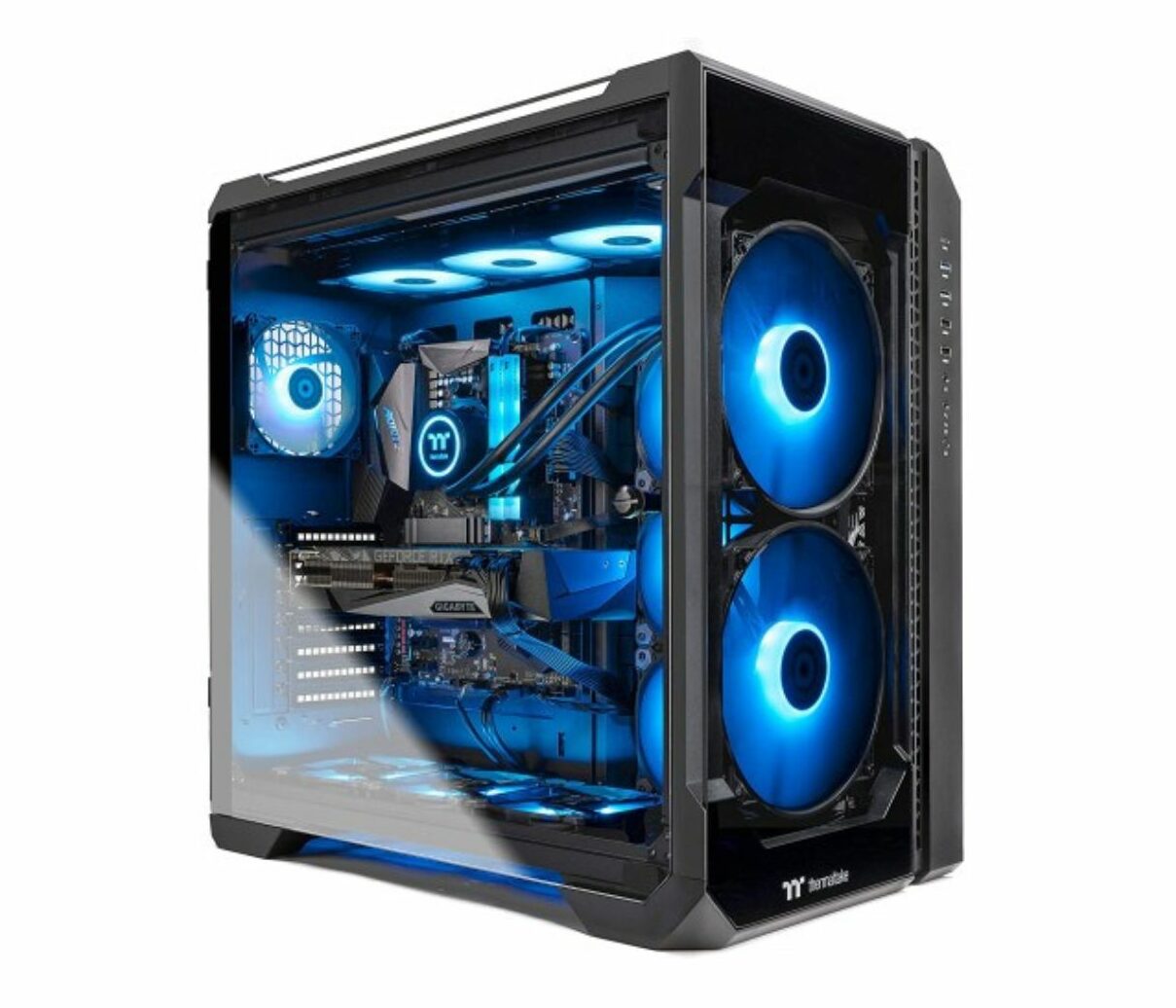
REASONS TO BUY
- Attractive aesthetics
- Excellent gaming performance
- Fantastic case with superb airflow
- High-quality construction
- Top-of-the-line cooling
- Easily upgradeable
REASONS TO AVOID
- Incredibly overpriced
- Worst performance per dollar by far
- Pitiful amounts of RAM and storage
- Much better options in this price range
Our Rating: 8.6/10
Finishing off our list here is Thermaltake’s take on one of the most expensive gaming PCs you can buy. If you’ve taken a look at the spec rundown as well as the price, you might find yourself asking the same question that we’re asking. Why is this computer that expensive?
If this were a list of PCs that were going to unjustifiably harm your wallet the most, we might be placing it a bit higher up. Unfortunately, that’s not quite what this list is about. While we are looking at the most expensive PCs, that doesn’t mean our candidates have to be overpriced. That’s why it’s a bit disappointing to see Thermaltake’s high-end PC, the LCGS View 390, priced so unfairly high.
Currently, it’s the second most expensive PC on our list, sitting right under the highly impressive MSI MEG Aegis Ti5. The LCGS also just happens to be the worst-performing PC on our list. Something isn’t quite right here. If the above statement regarding price still holds true as you’re reading this, then, unfortunately, Thermaltake’s LCGS View 390 is one to avoid for now.
The only thing it really has going for it is an RTX 3090. Ok great. The RTX 3090 is a very powerful GPU. It should be able to account for maybe a fourth of this PC’s price. It’s a bit difficult to tell you where the rest of your money would be going.
Its Ryzen 7 5800X CPU is another very powerful processor, but its power definitely isn’t enough to warrant the PC’s price tag. This is especially true when you consider that you have the other seven entries on our list to compare it to. While this processor is excellent for modern standards, it is still well behind the chips present in your other options here.
So if raw processing power isn’t the main selling point, what is? Well, it definitely isn’t the pitiful 16GB of RAM included. We’ve stated that 32GB, while technically enough for most situations, is a bit underwhelming for a top-tier PC. 16 GB crosses over into the territory of being straight-up unacceptable. There is absolutely no reason why a PC as expensive as this one should only have 16GB of RAM.
Likewise, you aren’t going to be buying this PC for its storage memory. It’s tied with the Prism II for the least amount of storage but doesn’t offer the Prism II’s insane performance capabilities. 1 TB is barely enough to get you by with your basic programs and a couple of games, it isn’t anywhere near what you’d want to have to be able to hold on to a full library of games.
The one thing this PC does have going for it is its case. As the company’s namesake might suggest, Thermaltake’s LCGS View 390 will be able to maintain comfortable thermals in even the most extreme circumstances. It is very breathable in its interior and has nine external fans to capitalize on that airflow potential. Along with that, the AIO liquid cooler attached to the CPU is going to keep it from ever overheating.
If you want the coolest case, then yeah, the LCGS View 390 by Thermaltake is pretty good. Unfortunately, there isn’t much of a reason to buy it aside from that or a pure desire to burn cash. This seems to be another case of overpriced gamer-branded tech–Stay away.
- RELATED ARTICLE: Biggest Gaming Monitors
In Conclusion
We had a lot of fun taking a look at some of the most expensive gaming PCs you can buy today. When you think about how far technology has come since the invention of the first computer, the progress is kind of absurd.
Whether you were reading to find the next PC to spend your hard-earned money on or if you were just here to indulge in a bit of online window-shopping, we hope you enjoyed your read! Hopefully, you’ve found the specs of what’s available today to be a bit interesting to gawk at. Modern technology is truly remarkable.
As always, thank you for reading. If you have any questions or comments, we would welcome you to share them below–We love hearing from you!









Be the first to comment